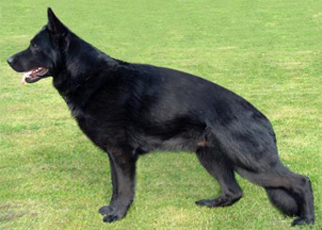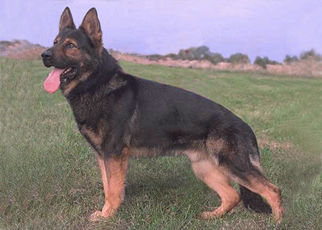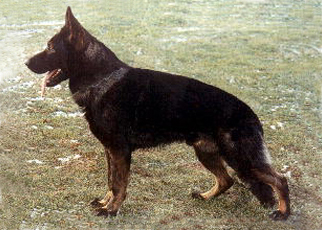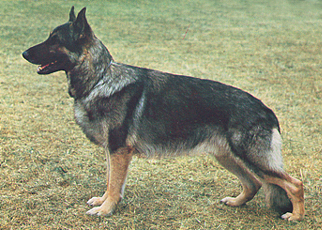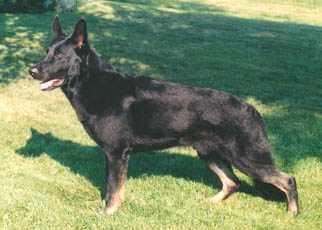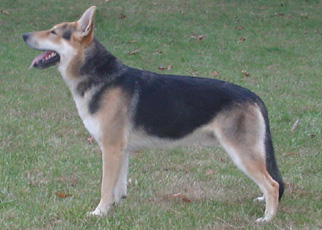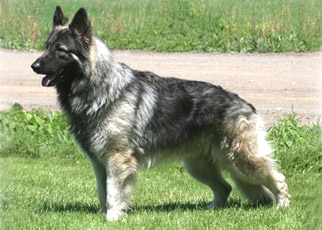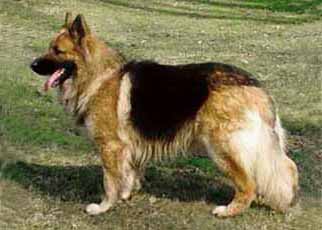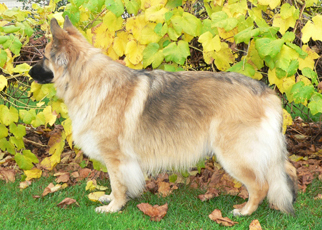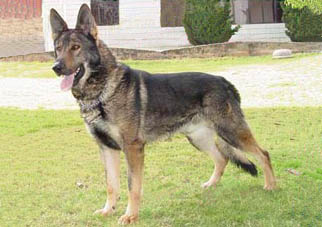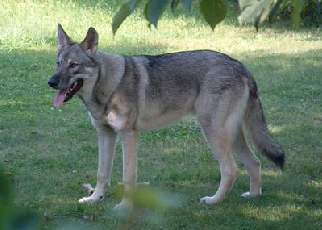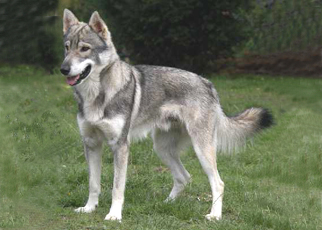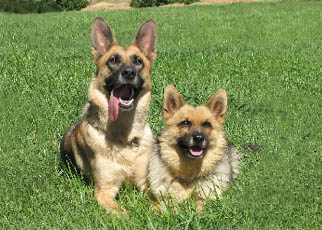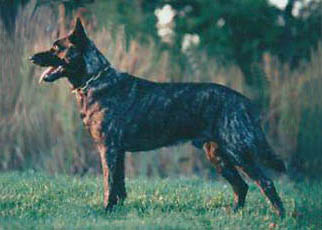Large shepherd dogs. What breeds of shepherd dogs exist
German shepherds- noble and strong animals, enjoying great love all over the world. These beautiful fearless dogs are distinguished by intelligence, a high degree of trainability, courage and devotion.

Origin of the breed
Historians prefer the version that shepherd dogs arose from the mixing of domesticated herd dogs with the so-called "bronze dog" (Indonesian wolf), whose habitat in the Bronze Age stretched from Scandinavia to the North-West of Russia. The mestizos were gradually tamed by shepherds, subsequently using them for guarding and grazing livestock. The first written mention of this breed dates back to the 7th century AD. The source reports that the killers of such dogs were severely punished by the authorities. The 16th-century Swiss zoologist Konrad Gesner, in his four-volume History of Animals, gives a must for loyalty to shepherd dogs and describes them as extremely loyal, capable of dying for the owner of the dogs.
The modern version of the breed was developed in eastern Germany at the end of the 19th century. As an independent new breed of dog, the German Shepherd was first seen at an exhibition in the German city of Hanover in 1882. Demonstrated a dog named Greif. Greif was later considered the official ancestor of the breed. The founder of the breed is the dog breeder Max von Stefanitz, who in 1891 opened and headed the breed lovers club. The activities of the club have made a huge impact on the popularization of German Shepherds.
Main characteristics
The very first breed standards for German Shepherds were described by club members at the end of the 19th century. Subsequently, the standards were repeatedly supplemented and revised. The last version was adopted in 2010.
"Germans" are big dogs, strong build, muscular. Correct proportions body, allow the dog to move freely and freely. Height at the withers: bitches - from 55 to 60 cm, males - from 60 to 65 cm. The skull is square, the head is long, wedge-shaped. Strong jaws, powerful bite, scissor bite. The eyes are dark, almond-shaped. The tip of the nose is strictly black. The ears are triangular and erect. Strong and strong back, well-developed chest. Large, muscular legs. The coat is short, coarse, with a fairly thick undercoat. Acceptable colors: zone gray, black, black with brown markings, different shades.
German Shepherd personality
Canadian professor of psychology S. Koren in his rating of the smartest dog breeds, put the German shepherd in the top three.
The German Shepherd has nordic character, glandular nerves, perfectly amenable to training, very mobile. One of the main advantages of this noble dog is fearlessness. It is quite easy to relate to the change of satellites, which is indispensable in the civil service. Thinly feels danger, hardworking, non-conflict. Poor loneliness.
He chooses one owner from the family members. Great for children and people with disabilities, which characterizes her as an ideal companion or guide dog for the blind. Reacts appropriately to the presence of pets. Survivable.
It is not recommended to have a shepherd dog, not experienced in training people.
Areas of use
Of the service breeds, this is the most versatile and widely used. Dogs have proven themselves well at: border, police, military, customs, services. Harsh bodyguards and watchmen.
Heroically proved themselves during the I and II world wars, where they played the role of orderlies, scouts, signalmen of sappers.
They are reliable and competent livestock herders.
Health. Care. Content
"Germans" do not have any special health problems. They have strong immunity. Puppies are vaccinated against plague, rabies, enteritis, hepatitis. Need regular ear cleaning.
The diet is standard for service dogs.
During the periods of autumn and spring molting, they need daily combing. The rest of the time - once a week. In winter, claws should be trimmed. Bathing is enough 3-4 times a year.
Pictures of german shepherd









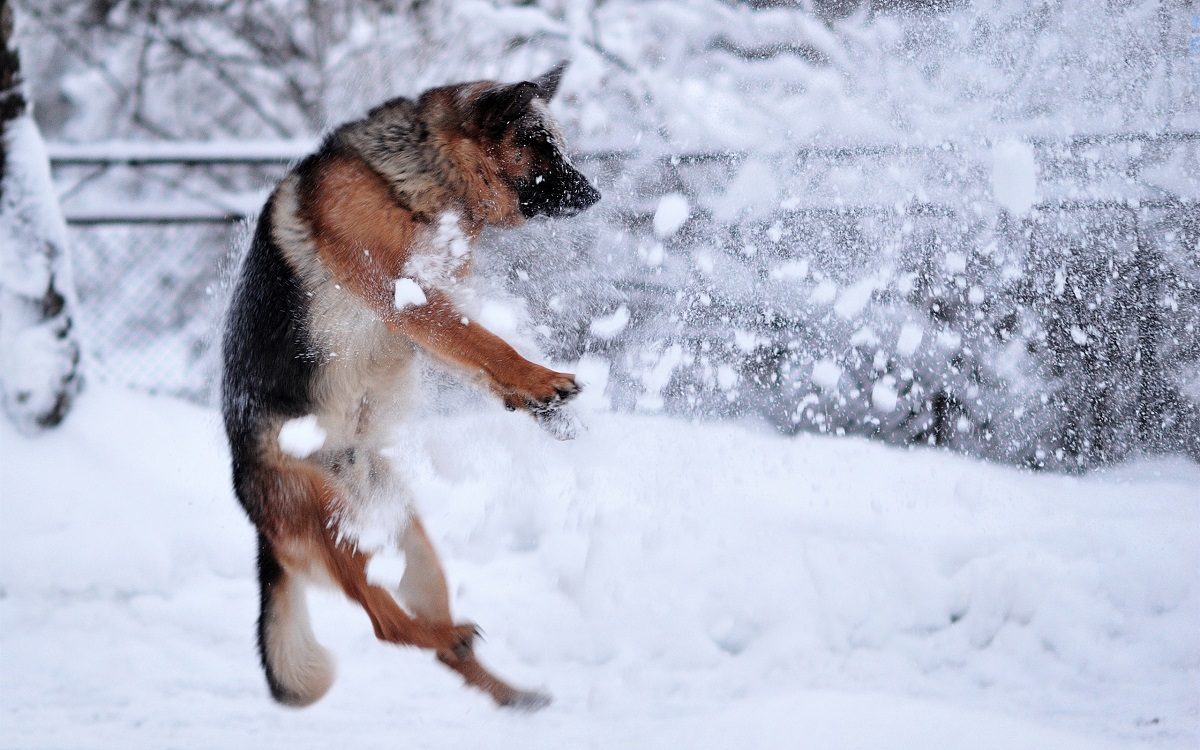
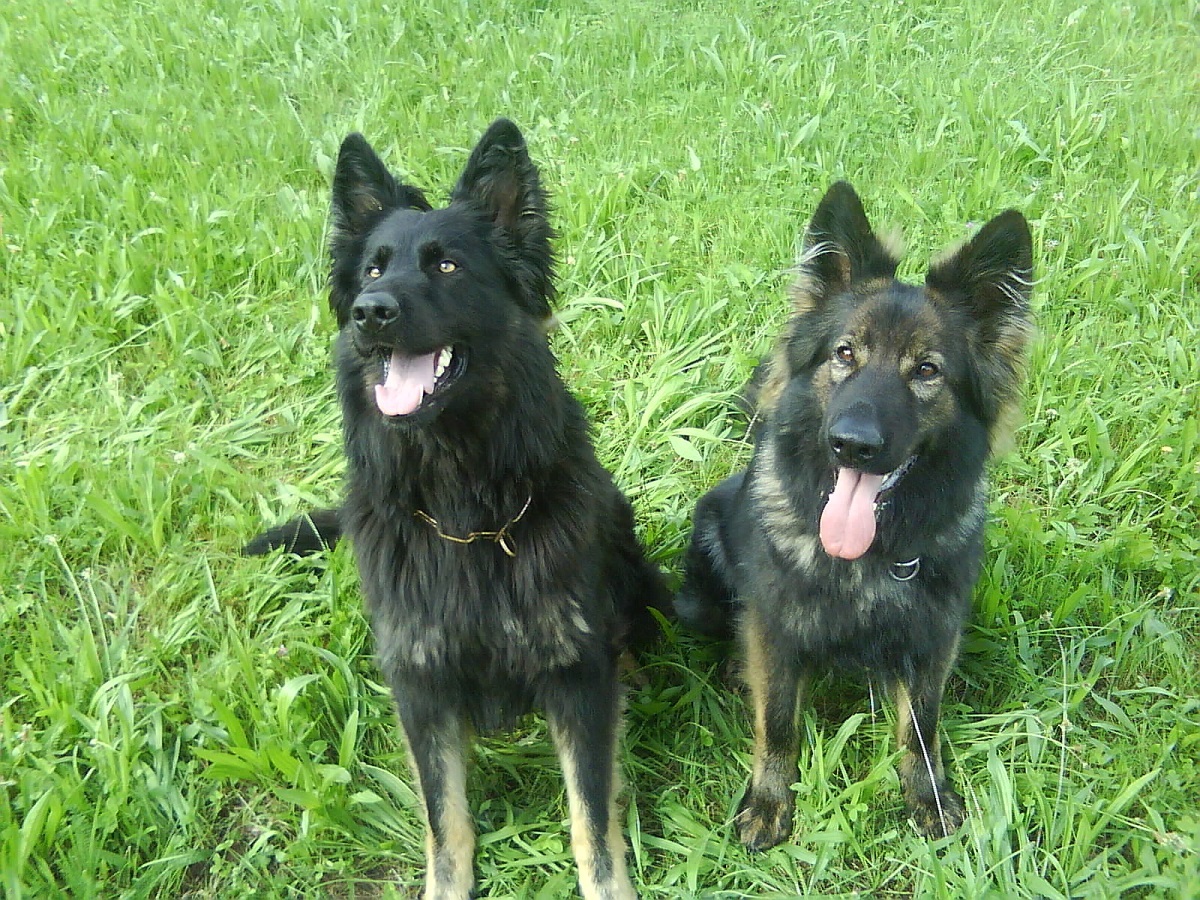
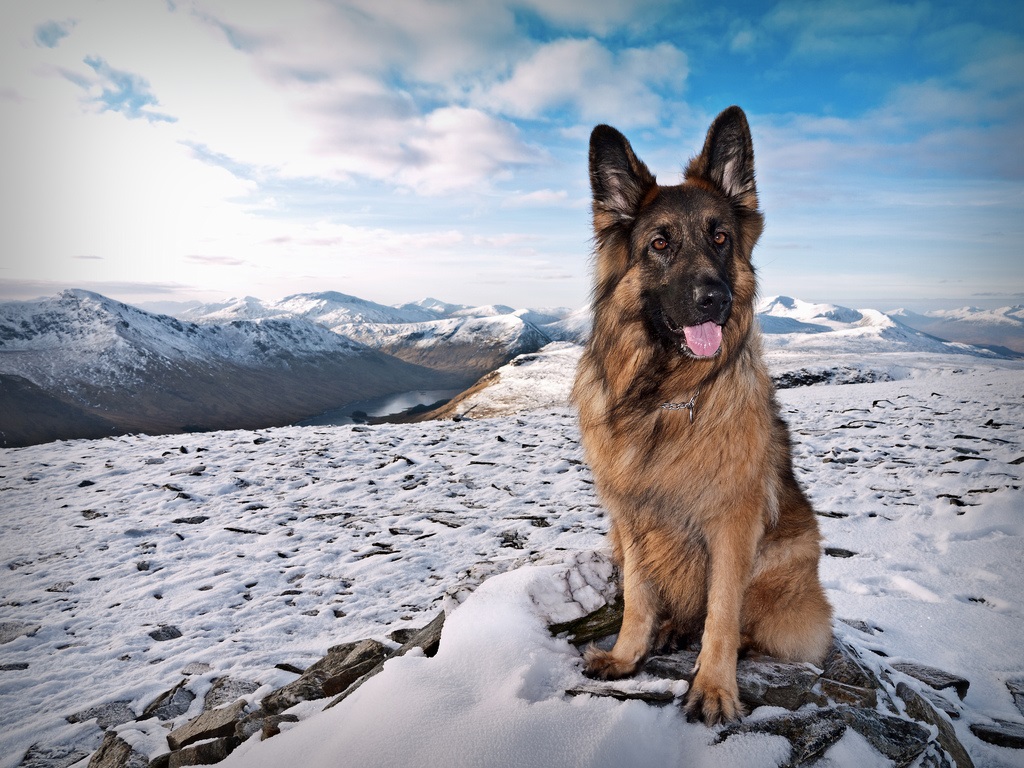
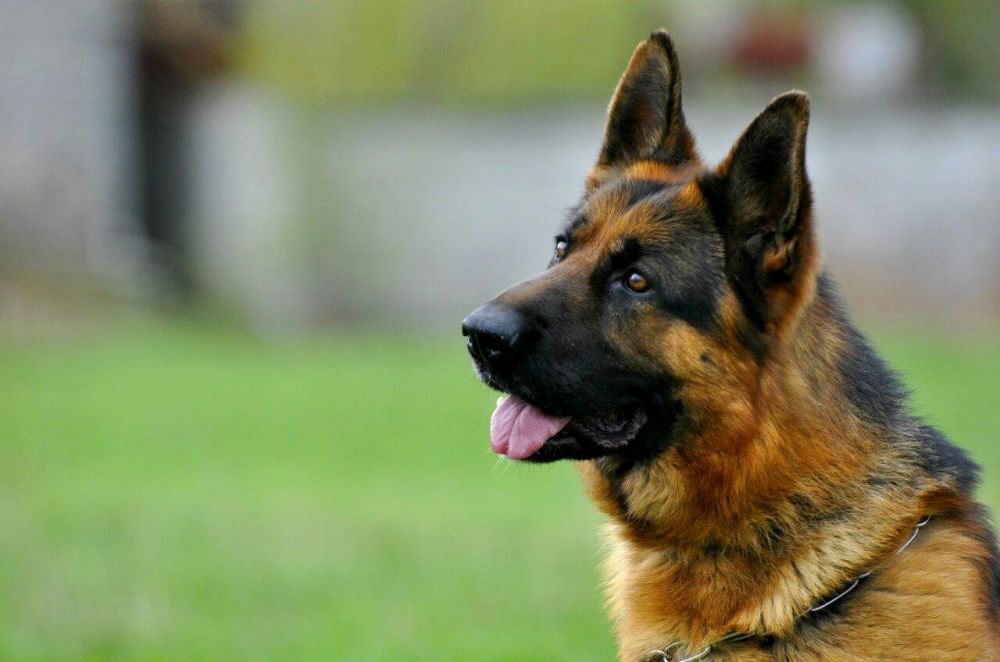
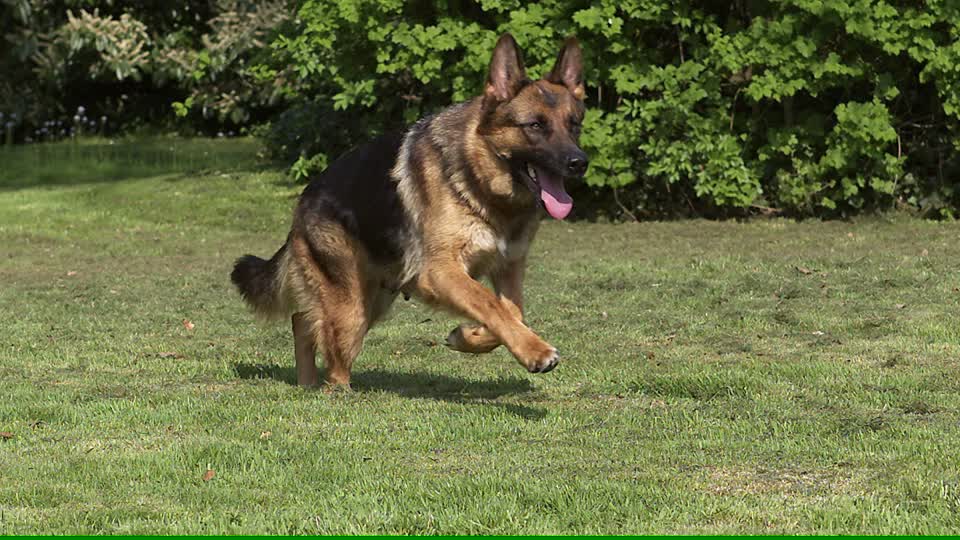

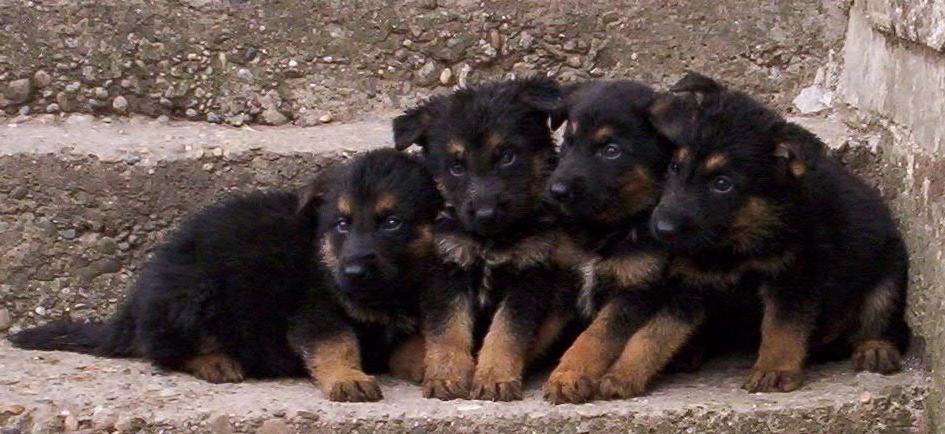
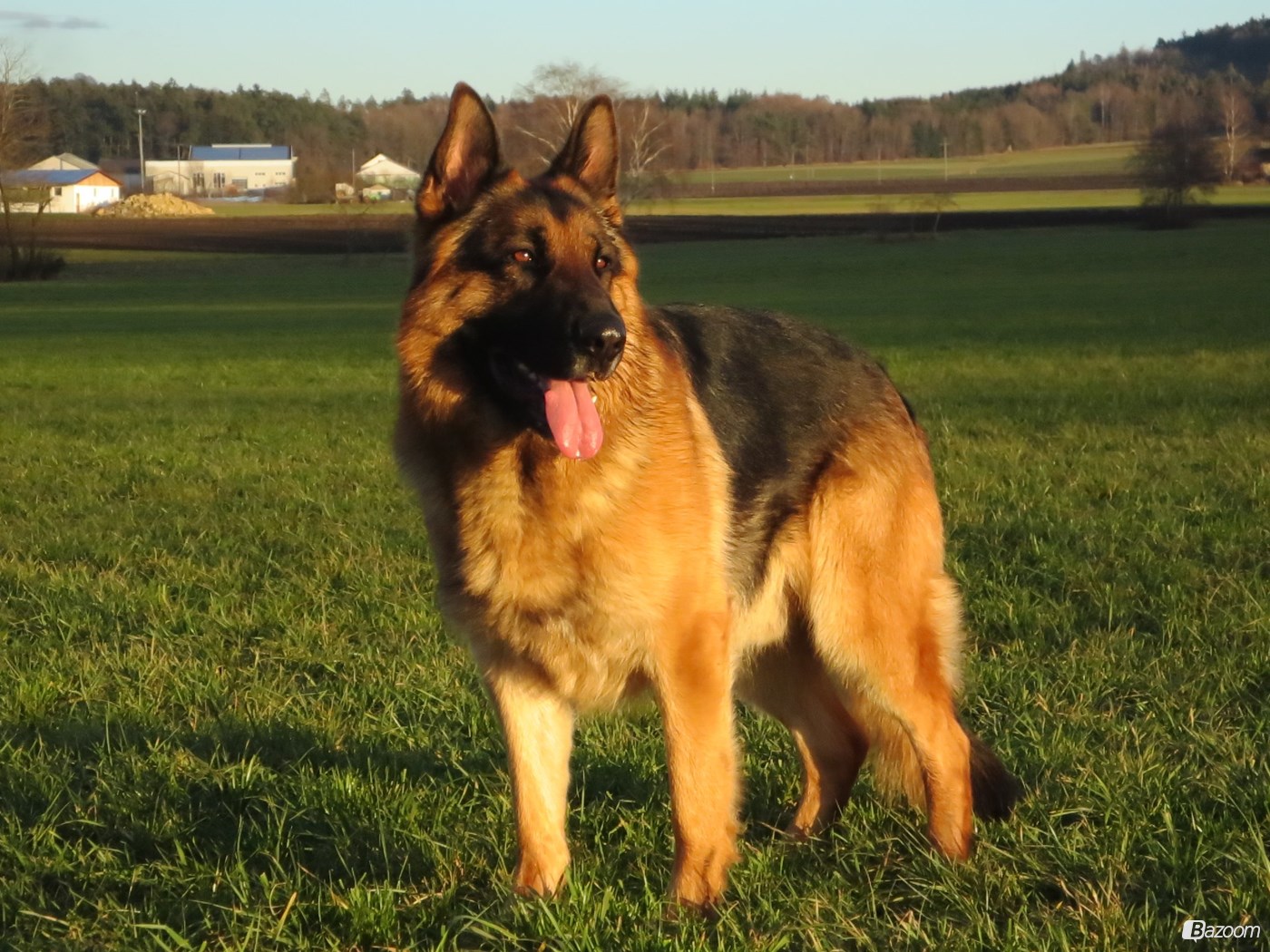
Few facts
German Shepherds are the most popular dog breed on Earth.
There are many monuments to these wonderful dogs in the world.
Many stars prefer dogs of this particular breed. As a friend of the "Germans" they preferred: Ben Affleck, James Belushi, Jennifer Aniston.
This is the most popular breed in Germany. which, moreover, is probably the closest to the standards. Samples of this family are successfully exhibited, bred, work as shepherds, serve as guides and companions at sporting events. They are widely represented all over the world, passing under the German system, which assumes the presence of working qualities and the possibility of breeding. They are predominantly black and red in color and show a smooth, creeping step on the ground. The main defects of the breed: uneven back, the disappearance of pigmentation and weak character
German Shepherd (working lines)
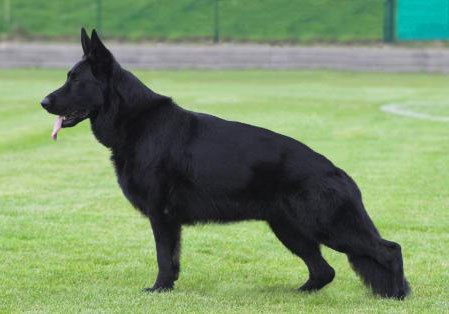
It also includes the Belgian and Danish lines, which, however, have nothing to do with the Belgian or Danish shepherd dogs - see below.
These dogs were bred primarily for the Schutzhund sport and as service dogs. They are singled out as police officers, service-military, dogs for detecting explosive devices and drugs. If you really need a working dog or companion for sporting events, this is the breed line you should look at first. Yes, maybe this dog will not seem elegant to you, like many from the show, but it has an excellent constitution and strength.
Sable, black or tricolor is considered typical, as is black and brown in general. He has a more aggressive and temperamental disposition than he would like to have for a guide dog or pet, however, there are other breeds for this purpose.
German Shepherd. Eastern german line
This line was created on the basis of those dogs that remained in the East of Germany.  after the Second World War. Those subspecies that preceded those bred after the war were not distinguished by either obedience or agility. East Germans represent dogs with an excellent physique and a set of working qualities: they have heavy bones, a large head and a serious disposition, in addition, they are very capable. Some dogs can be especially aggressive.
after the Second World War. Those subspecies that preceded those bred after the war were not distinguished by either obedience or agility. East Germans represent dogs with an excellent physique and a set of working qualities: they have heavy bones, a large head and a serious disposition, in addition, they are very capable. Some dogs can be especially aggressive.
Some breeders try to keep the oriental line clean, but it is common to integrate them with other working lines for the greatest success.
German Shepherd - American Line
This lineage has predominated numerically in North America since the beginning of 1970, when a whole strong line was obtained from several dogs and when the American and Canadian Club 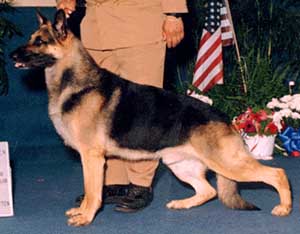 dog breeders from this line were not required to have any working qualities, nor to standardize the height of the hip. In general, this dog was bred to walk quickly, so it has an excessive body length and a rather angular shape. Unfortunately, the extreme physique required by the judges for this line does not match the running or jumping that is supposed to be for the working lines.
dog breeders from this line were not required to have any working qualities, nor to standardize the height of the hip. In general, this dog was bred to walk quickly, so it has an excessive body length and a rather angular shape. Unfortunately, the extreme physique required by the judges for this line does not match the running or jumping that is supposed to be for the working lines.
The temperament of this dog is rather mild, the activity is variable. Of the shortcomings - weak nervous system, however, as well as health in general. Recently, breeders have been experimenting a lot with the development of the qualities of a shepherd, agility and obedience for this breed. The best representatives this kind can make good family members.
Old american line
 The old American line, withdrawn before 1970, did not show any special results and was mostly canceled out by the withdrawal of the new American line. At the same time, in Germany, this line did not stand out as any special working or exhibition line and is very close in kinship to the rest of the American lines. Dogs such as Marko Cellerland, Bernd and Bodo Lierberg were excellent show dogs, from which they were then bred for shows and even for work. German dogs won at American shows and became the ancestors of American champions, dogs of the second and third generations were actively used as service dogs in North America. No special qualities stand out for this line.
The old American line, withdrawn before 1970, did not show any special results and was mostly canceled out by the withdrawal of the new American line. At the same time, in Germany, this line did not stand out as any special working or exhibition line and is very close in kinship to the rest of the American lines. Dogs such as Marko Cellerland, Bernd and Bodo Lierberg were excellent show dogs, from which they were then bred for shows and even for work. German dogs won at American shows and became the ancestors of American champions, dogs of the second and third generations were actively used as service dogs in North America. No special qualities stand out for this line.
German Shepherd. White. (Swiss line)
White is a dominant hidden gene that, when manifested, is disqualified in many countries. 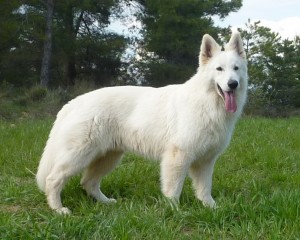 Lovers of white Germans conducted campaigns for the recognition of this line in wide circles, but they only achieved that the FCI system singled out this line in a separate breed - the Swiss Shepherd. Although in North America they still pass under the guise of a German Shepherd, or are officially recognized as Canadian and American White Shepherds.
Lovers of white Germans conducted campaigns for the recognition of this line in wide circles, but they only achieved that the FCI system singled out this line in a separate breed - the Swiss Shepherd. Although in North America they still pass under the guise of a German Shepherd, or are officially recognized as Canadian and American White Shepherds.
In general, the dogs have a good build, a little, however, too big in size, but with a pleasant soft disposition and variable temperament. They are often used as guide dogs, SAR service dogs, where White color can be used more effectively. There are no health problems associated with white or lethal outcome for posterity, it is also not a sign of albinism. Dogs should have dark pigmentation of the eyes, black nose, skin, lips, paw pads and nails.
Panda
Currently considered a branch of the AKC family, just like the American White described above. Shepherd dog, but is registered as a German shepherd line, which unexpectedly showed a spontaneous mutation in the form of a scattering of black specks on the face and represents a pattern of stable autosomal inheritance, as a result of the action of only one gene.
Shepherd dog, but is registered as a German shepherd line, which unexpectedly showed a spontaneous mutation in the form of a scattering of black specks on the face and represents a pattern of stable autosomal inheritance, as a result of the action of only one gene.
This line shows at the same time a good physique and an excellent, stable temperament, it has no visible deviations in physiology and it has a separate status for breeding, independent from other lines.
The unique genetic history of this breed has been studied at the University of California, the Center for Genetics and Veterinary Medicine, and the Institute of Veterinary Medicine and Medicine of America.
 Sheepdogs without a mask
Sheepdogs without a mask
This is only a color variant that is characterized by the absence of a typical black mask, and often by the appearance of dull or lightened dots on the face, chest and legs. It can also appear as sable and white patterns. White spots indicate low pigmentation, but not wolf blood, although crosses with wolves often show similar coloration. A black mask is a typical breed characteristic that is generally required by most judges, but its absence is not, strictly speaking, a sign of color fading.
Shiloh Shepherd
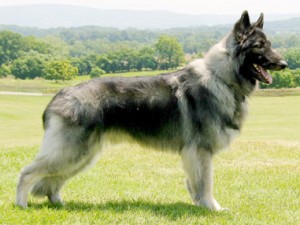 The line began to develop in America as a result of the increased interest in show types of dogs, as well as an attempt to recreate in dogs the original qualities of typical German Shepherds. The Alaskan Malamute was crossed with the Sarplaninac breed to increase the size of the dog. The result is very big dog at least 30 cm at the shoulders. The dog does not pass the AKC lineage, but is recognized by the International Shiloh Shepherd Registration System (ISSR). For a given breed line, all coat lengths and colors are acceptable. The ears are slightly smaller than the standard German Shepherd Dog. Temperament can be medium or soft. Dogs may vary in their agility.
The line began to develop in America as a result of the increased interest in show types of dogs, as well as an attempt to recreate in dogs the original qualities of typical German Shepherds. The Alaskan Malamute was crossed with the Sarplaninac breed to increase the size of the dog. The result is very big dog at least 30 cm at the shoulders. The dog does not pass the AKC lineage, but is recognized by the International Shiloh Shepherd Registration System (ISSR). For a given breed line, all coat lengths and colors are acceptable. The ears are slightly smaller than the standard German Shepherd Dog. Temperament can be medium or soft. Dogs may vary in their agility.
Despite the fact that due to their exorbitant size and predominantly soft nature, dogs of this line are not taken as police and service dogs, they, nevertheless, can become irreplaceable companions and guides.
German Shepherd. Long-haired line (Old German Shepherd)
 It is not a separate breed. The recessive gene for long hair is present in all lines and subspecies of the Germans and manifests itself only in "increased shaggy" in relation to normal cases. In different cases, there is both a barely noticeable lengthening of the hair, and an overly long coat, which is not easy to care for, removing ice, preventing the formation of clumps. In Germany, the presence of long hair is considered a defect in the breed, therefore such dogs cannot be exhibited.
It is not a separate breed. The recessive gene for long hair is present in all lines and subspecies of the Germans and manifests itself only in "increased shaggy" in relation to normal cases. In different cases, there is both a barely noticeable lengthening of the hair, and an overly long coat, which is not easy to care for, removing ice, preventing the formation of clumps. In Germany, the presence of long hair is considered a defect in the breed, therefore such dogs cannot be exhibited.
However, precisely because of the strict requirements for the length of the coat in Germany, in central Europe, this line was developed as an "old long-haired German shepherd", albeit without any rights to official registration and work, without specific genetic lines for breeding. (Contrary to this, dogs of this line are still successfully used as shepherds and service dogs). Offspring from crossing long-haired dogs with short-haired dogs, which, however, also carry the recessive trait of long hair, will have normal characteristics of a standard, that is, a coat of normal length.
Royal shepherd
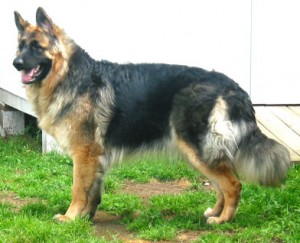 This is an example of an attempt to create a huge, long-haired German Shepherd in America. The ARBA system officially accepts this breed. To increase the size of the dog, Malamute, Akita and some other breeds were crossed. By the standards of this breed, it is required to have the largest size and massive build. The dog is perfect as a companion or as a pet, its incredible size and soft docile nature do not allow using it as a service or working breed.
This is an example of an attempt to create a huge, long-haired German Shepherd in America. The ARBA system officially accepts this breed. To increase the size of the dog, Malamute, Akita and some other breeds were crossed. By the standards of this breed, it is required to have the largest size and massive build. The dog is perfect as a companion or as a pet, its incredible size and soft docile nature do not allow using it as a service or working breed.
Kunming shepherd
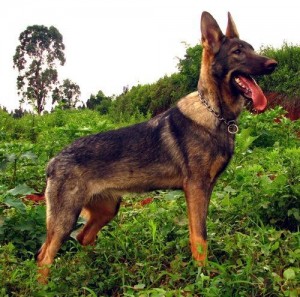 Sheepdog, bred in Communist China, after the image of the German Shepherd, but with more boxy body proportions and longer legs. In this line, there is a high probability of early crossing with outbred individuals. All colors typical for Germans are acceptable, variegated color is also possible. This line was created for the military service of the Yannan province, in which Kuming is the capital. The line was identified in the 1950s, after crossing 10 Peking military wolfhounds, probably related to a German shepherd, 20 local dogs tested and 10 German shepherds imported from Germany. These dogs are actively used in China as military, police and SAR service dogs.
Sheepdog, bred in Communist China, after the image of the German Shepherd, but with more boxy body proportions and longer legs. In this line, there is a high probability of early crossing with outbred individuals. All colors typical for Germans are acceptable, variegated color is also possible. This line was created for the military service of the Yannan province, in which Kuming is the capital. The line was identified in the 1950s, after crossing 10 Peking military wolfhounds, probably related to a German shepherd, 20 local dogs tested and 10 German shepherds imported from Germany. These dogs are actively used in China as military, police and SAR service dogs.
Compared to their German brethren, Chinese Shepherds have lost that elegance of gait. They are of medium size and a wide variety of temperaments. Unfortunately, it is not possible to compare their working qualities with the subspecies bred in the West of China, but these have established themselves as excellent companions, characterized by stability in the psyche and a high learning ability.
Belarusian shepherd
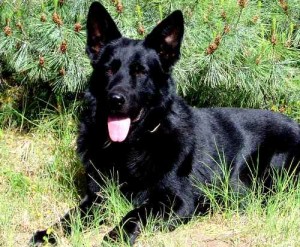 an attempt to recreate the line of the German shepherd in the USSR in the 1930s, crossing the German shepherd with the Central Asian, Russian huskies and other local species to fix the dog's resistance to cold trait, a trait, in my opinion, superfluous - a typical German shepherd dog showed itself excellently in Canada and North. In 1964, the Belarusian Shepherd Dog was recognized as a separate breed from the German line. These dogs were widely used as service, security dogs under the KGB system. The breed is characterized by black and dark colors, as well as pure white and spotted. Possible blue pigmentation of the eyes. They are very tall dogs - up to 28 inches in height, possibly taller. Despite the fact that dogs are widely promoted as a replacement for the German shepherd, they are extremely big size creates problems for working with them, so, except in the security industry, they have never been recognized anywhere, as opposed to the best working lines from the West.
an attempt to recreate the line of the German shepherd in the USSR in the 1930s, crossing the German shepherd with the Central Asian, Russian huskies and other local species to fix the dog's resistance to cold trait, a trait, in my opinion, superfluous - a typical German shepherd dog showed itself excellently in Canada and North. In 1964, the Belarusian Shepherd Dog was recognized as a separate breed from the German line. These dogs were widely used as service, security dogs under the KGB system. The breed is characterized by black and dark colors, as well as pure white and spotted. Possible blue pigmentation of the eyes. They are very tall dogs - up to 28 inches in height, possibly taller. Despite the fact that dogs are widely promoted as a replacement for the German shepherd, they are extremely big size creates problems for working with them, so, except in the security industry, they have never been recognized anywhere, as opposed to the best working lines from the West.
Dwarf german shepherd
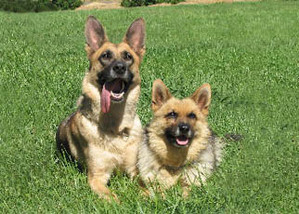 This is not a miniature copy of the German Shepherd, but a genetic defect called slimy short stature, which can be followed by a variety of health problems. It is found in many breeds and requires long-term veterinary supervision, health and coat care. Dwarfs are usually recognizable by birth and are not animals that have been delayed in growth development due to health problems.
This is not a miniature copy of the German Shepherd, but a genetic defect called slimy short stature, which can be followed by a variety of health problems. It is found in many breeds and requires long-term veterinary supervision, health and coat care. Dwarfs are usually recognizable by birth and are not animals that have been delayed in growth development due to health problems.
The next problem for these dogs includes the presence of diseases such as pannus, thyroiditis, allergies and hair loss. Some may become completely bald over time and not gain more than 20-30 pounds. Despite all the above shortcomings of the breed, its temperament has not suffered at all, and the character shows all the features characteristic of this breed. If cared for properly, these dogs can live a long happy life and become wonderful companions
Looking to make a four-legged friend? Pay attention to the shepherd dogs. These dogs will become your faithful companions. If you are interested in shepherd dogs, the types of breeds of these animals are completely diverse, although many ordinary people do not even know about it. Before buying a pet, you should familiarize yourself with all the options, examine their merits and learn about the care that your dog needs.
All Shepherd Breeds: Common Traits
If we talk about the general strokes of the subspecies of these dogs, then it is worth noting that they all belong to the shepherd. That is, regardless of the breed of shepherd dogs being bred, each can be used as a reliable assistant when grazing large and small livestock. Why exactly all varieties of shepherd dogs will become excellent shepherds? The fact is that they have important qualities for this, namely:
- Endurance. Dogs can work for a long time without losing their dexterity and activity.
- Strength and courage. To protect the herd from the attack of predatory animals, you need to be brave and have remarkable physical strength. When meeting, for example, a wolf, these qualities are very useful.
- Lack of hunting instinct. This is an important factor, since nothing should distract the four-legged shepherd from caring for the wards.
- Thick coat. If grazing takes place in a mountainous area, then the shepherd has to withstand significant temperature drops, prolonged exposure to the snow, etc.
Breeders around the world have taken these factors into account when developing new types of shepherd dogs. But, of course, during each experiment, certain adjustments are made, the peculiarities of the climate of the region and other important details are taken into account. Even in spite of any differences, each subspecies of dogs of this breed can be found in every corner of the planet.
If you are interested in a shepherd dog, the varieties of these animals can be considered in more detail.
Hardly anyone will argue that one of the most common and famous is. These are unusually intelligent animals, therefore they are often used for various official operations. For example, they are often “employees” of the criminal investigation department and other special services.
This variety lends itself well to training, therefore it is used in the filming of films.
Many viewers fell in love with the series "Mukhtar", in which a German shepherd played one of the main roles. Moreover, animals of this breed are excellent watchmen. They are taken to guard private houses and household farms, warehouses and important government facilities.
The German shepherd breed is considered the reference. It was she who was taken as a basis by scientists to breed new subspecies. It is required to find out what specific modifications of this breed exist today. Among them:
- Exhibition (classical). External characteristics and the behavior of these animals is closest to the original. They are hardy, fast, often "work" in the police or serve as guides for people with disabilities. In addition, they are more often than others presented at exhibitions and competitions. Experts believe that one of the main disadvantages of this subspecies is their unstable nature, sometimes they are too aggressive towards others.
- Working German. When breeding this sample, specialists Special attention paid physical characteristics dogs. Not enough attention was paid to the exterior. The result is a very good working dog, a reliable companion and true friend... It is undesirable to keep this animal in the apartment as a pet. He needs to move a lot, release energy, that is, lead an active lifestyle.
- American. This type of shepherd dog was bred almost 50 years ago. It was assumed that it would be used as a companion in sports (for long walks or jogging). Outwardly, she looks a lot like classic look, but has poor health and an unstable psyche. It is ideal for family life, but not entirely suitable for military service. She has a disproportionate body, which does not give her the ability to easily jump over high obstacles.
- English. From the name it is clear that this species was bred in foggy Albion. The skeleton of the dog is massive, and the shape of the body is elongated. The character is calm, even mild. Unfortunately, this breed did not become popular and was supplanted by other varieties.
- Eastern. This line is considered one of the most successful of all the options. Representatives of this subspecies have an attractive exterior and are perfectly trainable. The only drawback (but rather serious) is the tendency of animals to excessive aggression.
- Czech (Slovak). This breed was created as a labor force in the territory of Czechoslovakia. In appearance and habits, it is very similar to the eastern branch.
- Cuming. This type of shepherd dog was bred in the Chinese province of the same name. The animals look little like the usual shepherd dogs, but they are just as hardy. In addition, they have a stable psyche and are remarkably trainable.
- Royal. The breed is a symbiosis of several subspecies of shepherd dogs. She has a very thick coat and a massive build. Therefore, she is unlikely to fit the role. service dog... She is closer to home comfort and leisurely games with the owners in the yard.

In addition to those already named, there are also shepherd dogs crossed with a wolf. This breed looks very similar to a fanged predator: gray color, high paws, etc. It is a fighting dog, aggressive, but psychologically resistant to stress.
The next modification, which I would like to dwell on in more detail, is the Caucasians. From the name of the breed, it immediately becomes clear that the habitat of these four-legged friends of man is the high mountain ranges of the Caucasus. It was geographic localization that largely predetermined appearance and the nature of these harsh animals. They have very large dimensions, sometimes exceeding their owners in weight. Thick coat and undercoat provide warmth and comfort during snowfalls, storms and other climatic collisions.
Caucasians are one of the most powerful and hardy dogs that exist today. They are distinguished by special devotion to their masters, while expressing increased distrust and alertness towards other people. They can be quite unfriendly and even ferocious towards outsiders. It's better not to joke with them, because you can get serious injuries. By the way, this applies to all shepherd dogs. No matter how cute and friendly these animals may look, their temper is quite cool and unpredictable.
- Groenendael (long-haired representative of the breed;
- tervuren (has long hair);
- malinois (short-haired subspecies);
- Laekenois (has a rough, rough coat).
Outwardly, all representatives of the Belgians are similar to each other: the same skeletal structure, the shape of the muzzle, a similar color.
Collie
This one is known to many people as the collie. Several decades ago, it was these dogs that were in vogue. Few people guessed then that they also belong to shepherd dogs. Their distinctive features are an oblong muzzle, long soft hair. These animals have a meek disposition, but in case of danger they can easily protect their master.
As you can see, there are many shepherd dogs in the world. In addition, crossbreeding occurs constantly. different types, as a result of which a new line appears. Therefore, it is difficult to accurately calculate how many breeds exist at the moment.One thing is for sure: a shepherd is a dog with many worthy qualities.
If you can find with her mutual language, then you will find a reliable companion for life. There is no more devoted and selfless creature on the planet than this four-legged pet. Give him your affection, love and attention, and he will certainly return everything to you a hundredfold.
The particular popularity of this outstanding breed has led to the creation of many subtypes in different countries... Since there are several separate offshoots of this breed, for those who dream of owning a real German Shepherd, the variations of this breed may seem downright incredible. I have compiled a list of all the related breeds I could find and tried to relate them to each other, taking into account temperament and obedience. One who seeks best type in a given breed, it must be remembered that, despite the excellent recommendation for one of the lines, all of them can still show mental and physical defects. Buyers should be careful when purchasing a dog from an experienced breeder who specializes in providing a subspecies that will meet all of the buyer's needs.
Virtually every branch is required to have superior size, intelligence and temperament to truly be considered German Shepherd. Superior size means oversized, that is, gigantic. While this quality can impress others, it is still a disadvantage for a working dog. In almost all working conditions, the most optimal size for a dog - average. A dog with an approximate weight of 60 to 90 pounds, has a balance of speed, strength and agility. None of the following breed offshoots have the same intelligence and temperament indicators as the standard German shepherd. Of course, most of these dogs can make great pets, however, it is the "Standard German Shepherd" that serves tens of thousands of varied professional and voluntary services around the world. In addition, it is used in the most popular work sport - Schutzhund, as it is distinguished by its ability to obey, track down and graze without question. No other line has ever been so close to the "German Shepherd" in terms of working qualities, however, since this line has its own difficulties, their properties have never been compared with each other.
Finally, I want to add that the German Shepherd is probably the best working breed. While there is nothing wrong with keeping this dog as a pet, it is not the main function of the breed. Breeding new subspecies of German Shepherds to meet the minimum living conditions in the suburbs is about the same as fabricating a BMW with an engine from sewing machines... Of course, they may look great and thus work for the owner's reputation, but the essence will be lost forever. If the owner of the animal is not going to seriously deal with the dog, as required by the breed standard, there are many other breeds, including offshoots from the genus, presented here, which are probably more suitable for purposes not aimed at professional work. If you cannot handle a working breed, please do not purchase a German Shepherd. Breeders who do not want to develop the working qualities of this breed should also look for another dog. The working qualities lost in the course of hybridization and breeding of subspecies are similar to the blurred smile of Mona Lisa - it seems that the beauty is still here, but the Greatness is gone.German Shepherd Dog - West Germany Show (High Lines)
VA1 Yasko v Farbenspiel SchH3 Kkl1 a
It is the most popular breed in Germany and is probably the closest to the standards. Samples of this family are successfully exhibited, bred, work as shepherds, serve as guides and companions at sporting events. They are widely represented all over the world, passing under the German system, which assumes the presence of working qualities and the possibility of breeding. They are predominantly black and red in color and show a smooth, creeping step on the ground. The main defects of the breed: uneven back, disappearance of pigmentation and weak character.
German Shepherd (working lines)
V Buster v Adelmannsfelderland SchH3 Kkl1 a
It also includes the Belgian and Danish lines, which, however, have nothing to do with the Belgian or Danish shepherd dogs - see below.
These dogs were bred primarily for the Schutzhund sport and as service dogs. They are singled out as police officers, service-military, dogs for detecting explosive devices and drugs. If you really need a working dog or companion for sporting events, this is the breed line you should look at first. Yes, maybe this dog will not seem elegant to you, like many from the show, but it has an excellent constitution and strength.
Sable, black or tricolor is considered typical, as is black and brown in general. He has a more aggressive and temperamental disposition than he would like to have for a guide dog or pet, however, there are other breeds for this purpose.German Shepherd. Eastern german line
SG Alk v Osterburg Quell SchH3 DPO2 WPO Kkl1 a
This line was created on the basis of those dogs that remained in the East of Germany after the Second World War. Those subspecies that preceded those bred after the war were not distinguished by either obedience or agility. East Germans represent dogs with an excellent physique and a set of working qualities: they have heavy bones, a large head and a serious disposition, in addition, they are very capable. Some dogs can be especially aggressive.
Some breeders try to keep the oriental line clean, but it is common to integrate them with other working lines for the greatest success.German Shepherd Dog - Czech / Slovak Line
Gent od Policie SchH3 IPO3 ZVV3 Kkl1
These dogs were bred in Communist Czechoslovakia as a typical working line. It is, in essence, the same as the East German line, from which this subspecies actually originated. As in the case of East Germans, many breeders try to preserve the true nature of the Czechoslovakian line and likewise, it is more often combined with other working lines.
German Shepherd - American Line
CH Hermsdorf "s Highland Wind CD, owned by Linda J Shaw
This lineage has predominated numerically in North America since the beginning of 1970, when a whole strong lineage was obtained from several dogs and when the American and Canadian Kennel Club did not require any working qualities or standardization of hip height from this line. In general, this dog was bred to walk quickly, so it has an excessive body length and a rather angular shape. Unfortunately, the extreme physique required by the judges for this line does not match the running or jumping that is supposed to be for the working lines.
The temperament of this dog is rather mild, the activity is variable. Of the shortcomings - a weak nervous system, however, as well as health in general. Recently, breeders have been experimenting a lot with the development of the qualities of a shepherd, agility and obedience for this breed. The best members of this genus can make good family members.Old american line
GV CH Yoncalla "s Mike
The old American line, withdrawn before 1970, did not show any special results and was mostly canceled out by the withdrawal of the new American line. At the same time, in Germany, this line did not stand out as any special working or exhibition line and is very close in kinship to the rest of the American lines. Dogs such as Marko Cellerland, Bernd and Bodo Lierberg were excellent show dogs, from which they were then bred for shows and even for work. German dogs won at American shows and became the ancestors of American champions, dogs of the second and third generations were actively used as service dogs in North America. No special qualities stand out for this line.
German Shepherd (English Line)
CH Shootersway Xanthos of Colgay
The line originates from old lines imported into the British Isles to modern, post-military German lines. These are dogs with heavy massive bones, long body, beautiful shoulders, soft temperament and fickle temperament. They were actively used as police dogs and guide dogs. But as a result of the weakening of English quarantine laws for the new breed, they were pushed out by working and show German lines.
Shawlein Easter Parade SchH3 AD CD TD TT CGC UCC OFA, CH ptd. Bred, trained, owned and loved by Linda J Shaw April 14, 1995 - May 27, 2009
As a result of crossing two lines with good or bad qualities, hybrids are obtained, the next presented line is precisely a hybrid, which, however, does not have any distinctive features of its progenitors. First exhibited as a first generation test of the East German Shepherd Corrie with the Canadian hybrid House Coon bitch, Tim is my homebrew dog and to be honest, I have never met a more reliable and determined dog. He perfectly proved himself that German Shepherds possessing high aggressiveness and agility, nevertheless, can be excellent companions, meek with small children and friendly with people, he made an excellent impression of the breed line with everyone with whom we met.
German Shepherd. White. (Swiss line)
CH Alhambra? S Fox Mulder, world "s all time top winning white. Bazilian Young Champion, Br. CH, Br. Grnd CH, Pan American CH, Grnd CH Pan-American, CH Argentino, Grnd CH Argentino, CH Americas y Caribe, CH Latin American, Int "l CH, World Champion 2004 & 2005.
White is a dominant hidden gene that, when manifested, is disqualified in many countries. Lovers of white Germans conducted campaigns for the recognition of this line in wide circles, but they only achieved that the FCI system singled out this line in a separate breed - the Swiss Shepherd. Although in North America they still pass under the guise of a German Shepherd, or are officially recognized as Canadian and American White Shepherds.
In general, the dogs have a good build, a little, however, too big in size, but with a pleasant soft disposition and variable temperament. They are often used as guide dogs, SAR service dogs, where white can be used more effectively. White is not associated with any health problems or death for the offspring, it is also not a sign of albinism. Dogs should have dark pigmentation of the eyes, black nose, skin, lips, paw pads and nails.Panda
Lewcinkas Franka von Phenom CD TC
Currently considered a branch of the AKC family, just like the American White Shepherd Dog described above, but is registered as a German Shepherd line that unexpectedly manifests a spontaneous mutation in the form of a scattering of black specks on the face and represents a pattern of stable autosomal inheritance, as a result of the action of only one gene.
This line shows at the same time a good physique and an excellent, stable temperament, it has no visible deviations in physiology and it has a separate status for breeding, independent from other lines.
The unique genetic history of this breed has been studied at the University of California, the Center for Genetics and Veterinary Medicine, and the Institute of Veterinary Medicine and Medicine of America.
There is no rare or desirable color for the German Shepherd. Blue, disqualified at once, silver, tan, cream and hardy red is also quoted as an exceptional color. Breeders who are experimenting with unusual random colors should remember that there is a Breed Standard and all dogs with random variations in color will not be registered as real German shepherds, no matter how wonderful they are. As a result of intraspecific crossing, dogs with substandard pigmentation are obtained, which have problems with the skin due to its improper pigmentation and, accordingly, vulnerability to ultraviolet radiation.
The picture shows a dog disqualified by color.Sheepdogs without a mask
This is only a color variant that is characterized by the absence of a typical black mask, and often by the appearance of dull or lightened dots on the face, chest and legs. It can also appear as sable and white patterns. White spots indicate low pigmentation, but not wolf blood, although crosses with wolves often show similar coloration. A black mask is a typical breed characteristic that is generally required by most judges, but its absence is not, strictly speaking, a sign of color fading.
Shiloh Shepherd
Acer "s Royal Flush of Zion
The line began to develop in America as a result of the increased interest in show types of dogs, as well as an attempt to recreate in dogs the original qualities of typical German Shepherds. The Alaskan Malamute was crossed with the Sarplaninac breed to increase the size of the dog. The result is a very large dog, at least 30 cm at the shoulders. The dog does not pass the AKC lineage, but is recognized by the International Shiloh Shepherd Registration System (ISSR). For a given breed line, all coat lengths and colors are acceptable. The ears are slightly smaller than the standard German Shepherd Dog. Temperament can be medium or soft. Dogs may vary in their agility.
Despite the fact that due to their exorbitant size and predominantly soft nature, dogs of this line are not taken as police and service dogs, they, nevertheless, can become irreplaceable companions and guides.German Shepherd. Long-haired line (Old German Shepherd)
It is not a separate breed. The recessive gene for long hair is present in all lines and subspecies of the Germans and manifests itself only in "increased shaggy" in relation to normal cases. In different cases, there is both a barely noticeable lengthening of the hair, and an overly long coat, which is not easy to care for, removing ice, preventing the formation of clumps. In Germany, the presence of long hair is considered a defect in the breed, therefore such dogs cannot be exhibited.
However, precisely because of the strict requirements for the length of the coat in Germany, in central Europe, this line was developed as an "old long-haired German shepherd", albeit without any rights to official registration and work, without specific genetic lines for breeding. (Contrary to this, dogs of this line are still successfully used as shepherds and service dogs). Offspring from crossing long-haired dogs with short-haired dogs, which, however, also carry the recessive trait of long hair, will have normal characteristics of a standard, that is, a coat of normal length.Royal shepherd
This is an example of an attempt to create a huge, long-haired German Shepherd in America. The ARBA system officially accepts this breed. To increase the size of the dog, Malamute, Akita and some other breeds were crossed. By the standards of this breed, it is required to have the largest size and massive build. The dog is perfect as a companion or as a pet, its incredible size and soft docile nature do not allow using it as a service or working breed.
Old style german shepherd
This is an attempt to go back to old good times breeding German Shepherds, which are characterized by such features as more than 30 cm in height at the withers, weighing more than 100 pounds. In addition, they appear to be dogs with a flat, straight back, in comparison to some American and German Shepherd dogs, which have a curved, arched spine. Many of them are long-haired.
In fact, all these qualities - incredible size, flat back, soft temperament, long hair - were never required for the breed standard of the German Shepherd Dog, but similar problems arise with other baselines of this breed, and yet conscientious breeders try to avoid such defects.A real old German shepherd dog from the early twenties
VA1 Erich v Grafenwerth
This dog's dry wiry construction, small chest volume, leg length and square proportions make the relationship with the Malinois (Belgian Shepherd) family quite prominent. Those who created this line were guided by the conviction of the need for more powerful dogs that would not lose their agility and speed. This line is history, as a result, breeders have created more successful subspecies and there is no point in going back to the roots.
Kunming shepherd
Sheepdog, bred in Communist China, after the image of the German Shepherd, but with more boxy body proportions and longer legs. In this line, there is a high probability of early crossing with outbred individuals. All colors typical for Germans are acceptable, variegated color is also possible. This line was created for the military service of the Yannan province, in which Kuming is the capital. The line was identified in the 1950s, after crossing 10 Peking military wolfhounds, probably related to a German shepherd, 20 local dogs tested and 10 German shepherds imported from Germany. These dogs are actively used in China as military, police and SAR service dogs.
Compared to their German brethren, Chinese Shepherds have lost that elegance of gait. They are of medium size and a wide variety of temperaments. Unfortunately, it is not possible to compare their working qualities with the subspecies bred in the West of China, but these have established themselves as excellent companions, characterized by stability in the psyche and a high learning ability.Belarusian shepherd
an attempt to recreate the line of the German shepherd in the USSR in the 1930s, crossing the German shepherd with the Central Asian, Russian huskies and other local species to fix the dog's resistance to cold trait, a trait, in my opinion, superfluous - a typical German shepherd dog showed itself excellently in Canada and North. In 1964, the Belarusian Shepherd Dog was recognized as a separate breed from the German line. These dogs were widely used as service, security dogs under the KGB system. The breed is characterized by black and dark colors, as well as pure white and spotted. Possible blue pigmentation of the eyes. They are very tall dogs - up to 28 inches in height, possibly taller. Despite the fact that dogs are widely promoted as a replacement for the German Shepherd, their extremely large size poses problems for working with them, therefore, except in the security industry, they have not been recognized anywhere, in contrast to the best working lines from the West.
Czechoslovakian wolf
The breed is confirmed by the FCI system (international canine organization), as a result of crossing a European wolf with a German shepherd to obtain more hardy and powerful shepherd dogs. While there is a separate line of Czech shepherd dogs, this one combined the qualities of a real wolf, as a result of which, its extraordinary aggressiveness and fighting features made it completely unacceptable for work, despite the fact that the dog still obeys commands and some use it as a sport.
The color is light gray, wolfish.
It has now been discovered by science that the domestic dog has evolved into the ability to anticipate human behavior and voice timbres, an ability that is not characteristic of an ordinary wolf. Therefore, crossing a dog with a wolf is probably not best idea, if in this case the dog loses these qualities.Sarluz Wolfhound
A breed confirmed by the FCI system as a Dutch genus, obtained by crossing a European wolf with a German shepherd dog to obtain a shepherd dog superior in quality to the previously obtained breeds. It also has increased resistance to nervous stress, lack of timidity and fighting qualities - (features officially included in the standard for this breed!), Which naturally made it inoperable.
The color can be wolf gray, light brown or completely white.
Interestingly, crossing dog breeds with wild wolves has gained popularity due to the fact that wild wolves have almost completely disappeared in Europe. For Europeans, the presence of such dog breeds in modern times has a certain romantic character, as a reminder of the days when their wild cousins were still found in nature. In North America, where populations of wild wolves still exist, such experiments with domestic dogs are frowned upon.Utonogan
this is another example of the increased fascination of wolves for Europeans. In this case, they crossed: German Shepherd, Malamute and Siberian Husky. This breed was bred not to fix the wolf traits in the dog's behavior, but to create a dog that resembles a wolf in appearance, but without the true admixture of wolf blood. For this breed, there are no factors that prevent it from becoming a good companion to humans or not being acceptable for work, the dog shows high degree learnability and good temperament.
American tundra shepherd
Unregistered hybrid of the North American Wolf and German Shepherd. Despite the fact that the dog is impressive in its size and large build, this is what prevents it from becoming a service dog. There is no official confirmation that this dog was recruited anywhere.
The color can be very diverse, adopted for a German shepherd or coyote. Also, the dog has a high back and a round back, which is not typical for a wolf. The percentage of wolf blood is not determined, the temperament can be unstable. Suffice it to say that the wolf predecessors of this hybrid are already widespread in North America, so there is no need to cross them with domestic dog breeds.
The picture shows an unregistered shepherd dog, but nevertheless, represented as a "forest" shepherd dog, a dog.Dwarf german shepherd
Remy SchH1 and dwarf Nemo AHBA HCT, photo courtesy of Julia Priest
This is not a miniature copy of the German Shepherd, but a genetic defect called slimy short stature, which can be followed by a variety of health problems. It is found in many breeds and requires long-term veterinary supervision, health and coat care. Dwarfs are usually recognizable by birth and are not animals that have been delayed in growth development due to health problems.
The next problem for these dogs includes the presence of diseases such as pannus, thyroiditis, allergies and hair loss. Some may become completely bald over time and not gain more than 20-30 pounds. Despite all the above shortcomings of the breed, its temperament has not suffered at all, and the character shows all the features characteristic of this breed. When properly cared for, these dogs can lead a long, happy life and make wonderful companions.Gypsy shepherd
This is a native shepherd breed from the Czech Republic, the development of which can be traced back for about five hundred years. If this breed originates not directly from the German breed line, then at least from its European counterparts. The dog is slightly smaller in size than the typical German Shepherd, although the resemblance to it is striking, it has a long coat of black and red color. This energetic, friendly dog makes an excellent companion or works in a wide variety of different services. This line is not registered under the FCI system, but is a national breed for the Czech Republic, and its increased popularity will ensure its recognition over time.
Altdeutscher Huetehunde (Old German Shepherd Dog)
Also a born shepherd dog, very popular in Germany, probably descended from related European shepherd lines. Some representatives of this line probably took part in the development of the German Shepherd as a breed. For the line, there are a variety of color schemes and coat lengths.
Belgian Shepherd Dog - Malinois
Originally from the North European Shepherd Dog, this Germanic breed was bred in the Belgian city of Malinois, it is smaller, lighter in weight and more athletic than its predecessors. It is equally well suited for police use, work in the main service industries, and for use in sports, for example in the French Ring, as well as Mondio, KNPV and Schutzhund. Other varieties of this breed are called Groenendael, Turveren and Laekenois.
Dutch shepherd
This line is incredibly similar to the Belgian Shepherd Dog, however, the presence of a variegated color is observed for it, long-haired variations are possible. Dogs of this line are also used for various services, in addition, in addition, they are sometimes crossed with the Belgian Shepherd dog to obtain more acceptable hybrids for sports and service.
Linda shaw(translation by Olga Raznoshinskaya)
Primary source, author of the articleArticle from the site and www.muxtar.com.ua
The German Shepherd Dog appeared in Germany by crossing them with wolves. Their height is 60-75 cm, and their weight ranges from 30 to 60 kg. The coat of the "Germans" is short and hard. The color is black, red or black and brown. German Shepherds are very smart and quick-witted, they easily learn many commands and are always loyal to their owner. These shepherd dogs love children, are friendly to the friends of the owners, but they treat strangers with some rage. Often they can be found in the army, police, detective work.
The Caucasian Shepherd Dog has existed for about three thousand years. The dog is of medium size, reaches 60-66 cm in height, and weighs up to 30 kg. The coat of this shepherd dog is long, thick and hard. The color can be from black to gray, red or brindle. Feature in color - black outlines around the eyes and chest. The Caucasian Shepherd Dog is calm, strong and self-confident. It was used for fighting and protecting property. But the training of this dog must be correct, otherwise you can get an extremely aggressive or, conversely, a cowardly individual.
Anatolian Shepherd Dog is originally from Turkey. This is one of the largest species of shepherd dogs. Her height is about 71-80 cm, and her weight is 40-55 kg. The color of the dog is always deer. Distinctive feature This Shepherd Dog is a dark muzzle mask. She has excellent musculature and speed. Because of this, it was used as a fighting and hunting dog. She could easily overwhelm a wolf or bear while hunting. Despite her size, she is kind to children, but only obeys the owner. These dogs are a little unsociable, but this does not affect the mind and ingenuity in any way.
The Central Asian Shepherd Dog or Mastiff is a fairly large dog. She has well-developed muscles and strong jaws. It was used as a herding dog, but now it can be found at home. She is unpretentious in care and in food, loyal to her owners. She is easy to teach about commands and good social behavior.
The Belgian Shepherd is a small dog 58-60 cm tall and weighing about 23 kg. The coat of these dogs comes in different lengths, from short to long. The color also ranges from red to dark brown. She is smart, loyal and friendly. The Belgian Shepherd Dog gets along perfectly with children, understands people well. But she is a little shy and shy. Due to their excellent memory, these shepherd dogs often serve in the police, and are also known as sentry and herding dogs.
The Australian Shepherd, despite its name, originated in America. This type of shepherd is small in size. Their height is 46-58 cm, and their weight is up to 25 kg. They have thick long hair. In color, they can be black, with white markings, red and even gray-blue. These dogs are very nimble, hardy and hardworking. They can run up to 60 km a day. These dogs are playful and kind to people, but also excellent watchmen. An Australian Shepherd should not be kept in an apartment; it requires a lot of space to move. Country life would be ideal for her to release all her energy.
Scottish Shepherd (collie) - pretty dog with long light hair. She is about 50 cm tall. Collie is smart, smart, but a little lazy. She was often used as a shepherd dog, and now you can see her as a guide for the blind. Like all types of shepherd dogs, she is loyal to her owners and loves children. But you need to train her with caution, because without the mood she can be harmful. Its long coat must be brushed out daily or it will deteriorate.
The Hungarian Shepherd or Komondor is the largest dog of this breed. Its height at the withers is 80 cm. The peculiarity of this shepherd dog is that it has unique wool, which is twisted in the form of dreadlocks. Its coat does not smell or shed, it does not need to be combed out and often washed. Such wool will save the dog at any whim of nature. Komondors used to serve as shepherds, and their appearance camouflaged them well in a flock of sheep. Despite their size, these dogs eat very little; about a kilogram of food per day is enough for them. They are very kind, get along with children and other animals, but do not know how to play.
Whichever shepherd you choose, you can't go wrong with choosing a family friend. Many of these subspecies have long been no longer used as herding or watchdogs; now they can only be seen as a pet or police assistant. With age, shepherd dogs become wise, sensible dogs, very calm and kind. But they do not lose their genetically based skills and will always protect the owner from harm.

